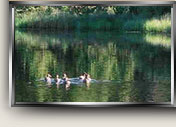Geology and Soils
Geology
At a deep level,
Vandevert Ranch lies at the western edge of the High Lava Plains
Province of Oregon. This volcanic zone dates back at least 5
million years and extends east beyond Burns. The Cascade range to
the immediate west of the ranch began rising about 1.7 million years
ago.
In more local space and time,
the ranch is near the northern end of what is known to geologists as
the La Pine Basin. The basin lies between the Cascade Mountain
Range on the west and Newberry Crater on the east and encompasses
the Spring River, the Fall River, and portions of the Deschutes and
Little Deschutes Rivers. The basin began dropping between the two
mountain masses between 600,000 and one million years ago. The
basin’s formation was concurrent with volcanism and deposition by
ancient glaciers. Periods of active volcanism and fluvial (river)
and lacustrine (lake) deposition created a complex sequence of
sediments hundreds of feet deep. Newberry lavas backed up against
Cascade Range lava flows starting about 700,000 years ago, blocking
the channel of the Deschutes River and creating a lake and marsh
environment over much of the basin. About 200,000 years ago
glaciers on the Cascade Range and Newberry Volcano changed the lake
and marsh to a river environment These river deposits created a
3–5 ft-thick layer throughout the
entire basin.
A late incidence
of the lake phenomenon occurred about 5050 BC when lava from
Newberry blocked the Deschutes River at Benham Falls. The resulting
Benham Lake covered much of the ranch until about 1,900 years ago.
There are two
lava outcrops near the ranch main gate and there is
basalt (i.e. lava), either fractured or solid, from eight to twenty feet
below the ground on all the lots on Schoolhouse Road where data is
available. It would seem likely that this lava came from Newberry
Volcano or one of its many parasitic vents.
Well logs are notoriously unreliable but,
interestingly, the log for the deep well near the Schoolhouse
indicates levels of rock (obviously from volcanic activity)
interlaced with levels of sand, gravel, boulders and clay that must
have been deposited by glaciers, lakes, and rivers. The deep well
by the barn (closer to the middle of the Deschutes/Little Deschutes
valley) shows no lava all the way down to 106 feet.
Material at Depths Drilled – From Ranch Well
Logs
|
Schoolhouse – for Pond |
Barn/Shop |
Schoolhouse Irrigation |
Homestead |
School - Hand Pump |
|
Completed July 4, 1991 |
June 30, 1994 |
February 18, 1994 |
April 12, 1989 |
January 16, 1994 |
|
0 – 7 feet deep |
Soil |
0 – 15 feet deep |
Soil, Pumice & Gravel |
0 – 12 feet deep |
Soil & Pumice |
0 – 4 feet deep |
Topsoil |
0 – 33 feet |
Gravel and Clay |
|
7 – 19 |
Gravel & Sand |
|
|
12 – 19 |
Clay & Gravel |
4 – 18 |
Clay |
|
|
|
19 – 25 |
Brown Clay |
15 – 25 |
Tuff* |
19 – 42 |
Brown Lava |
18 – 28 |
Cinders |
|
|
|
25 – 37 |
Gray Rock |
25 – 65 |
Gray Clay |
|
|
28 – 30 |
Lava Rock |
|
|
|
37 – 45 |
Gravel & Boulders |
65 – 68 |
Black Sand |
|
|
|
|
|
|
|
45 – 55 |
Gray Rock |
68 - 94 |
Green Clay |
42 – 78 |
Pink Lava |
|
|
|
|
|
55 – 100 |
Boulders, Sand, & Gravel |
94 – 103 |
Gray Clay |
78 – 80 |
Gray Lava |
|
|
|
|
|
100 – 110 |
Black Sand |
103 – 106 |
Black Sand |
|
|
|
|
|
|
* Tuff is a fragmental rock composed of small
volcanic detritus like ash and cinders.
For more
information see "Geological Cross-sections Nearby" in the appendices
and also the 2007 USGS Scientific Report, Evaluation of
Approaches for Managing Nitrate Loading from On-Site Wastewater
Systems near La Pine, Oregon available on the web. The
La Pine Study Area is a roughly north-south rectangle with its
northern boundary just north of Sunriver and south of Benham Falls
and Lava Butte.
Soils from
the Top Down
The top soil
layer of organic matter is less than an inch thick. It is less than
seven thousand years old and may be much younger. With some
variations, the next approximately two to five feet of soil is
volcanic ash (very small bits of rock and glass, similar to sand)
from the eruption of Mt. Mazama (Crater Lake) about 7,700 years ago
(5650 BC). Thin layers of Mazama ash exist as far away as
Saskatchewan.
Soils are classified not only by their overall
composition, but on the composition and color of various layers
within the soil, the slope of the soil surface, and the typical
water content of the soil. Except for the riparian area, all the
soils on the ranch are well suited to woodlands and are
characterized by low fertility, high water tables, and
susceptibility to compaction.
|
Soil Type |
Location |
Parent Material |
Native Plants |
Drainage |
Mgmt. Limits |
Appropriate Use |
|
Cryoquolis – 29A |
Riparian & flood plain |
Mixed alluvium |
Willow, birch?, sedges, rushes |
Poor to very poor |
High water table |
Riparian, grazing |
|
Shanahan loamy coarse sand,
0-15% slope – 114C |
Lots 1-8, land east of So.
Century |
Ash over old alluvium |
Ponderosa, bitterbrush, Idaho
fescue |
Somewhat excessive |
Low fertility, compaction |
Woodland |
|
Shanahan loamy coarse sand, 0-3%
slope - 115A |
SE corner of ranch, pasture west
of barn |
Ash over old alluvium |
Lodgepole, bitterbrush, Idaho
fescue |
Somewhat excessive |
Frost heaving, rooting depth?,
low fertility, compaction |
Woodland |
|
Sunriver sand loam – 144A |
Barn to Lot 21 |
Ash over old alluvium |
Lodgepole, blueberry, forbes |
Somewhat poor |
Soil depth, wetness, low
fertility, compaction |
Woodland |
A soils report done in 2006 to explore the
ramifications of re-excavating the pond advised as follows: “The
dominate soil type to be expected from the excavation is judged to
be a dark colored silty sand. Seams of fine gravel and more coarse
sand along with the occasional seam of finer grained soil will also
be included in the mix.” A dozen or more test pits dug in the
meadow west of the pond in 2006 found occasional thin layers of clay
or silty soil similar to clay. A layer of brown/yellow soil about
ten feet deep appeared to be weak rock when saturated with water but
disintegrated into sand when dry.
For more information see the
Oregon Soils Map, the
Ranch Soils Map, and
the
Geotechnical Report for the Pond Area in the appendices to this
Stewardship Plan. Also see the Soil Survey of Upper Deschutes
River Area, Oregon from the National Resources Conservation
Service (available on the web). Soils reports for selected
individual lots can be found in the Planning area of the Owners Only
section of this web site (password protected).
Continue to Hydrology and Nitrate Loading
Return to
Stewardship Plan Table of Contents






